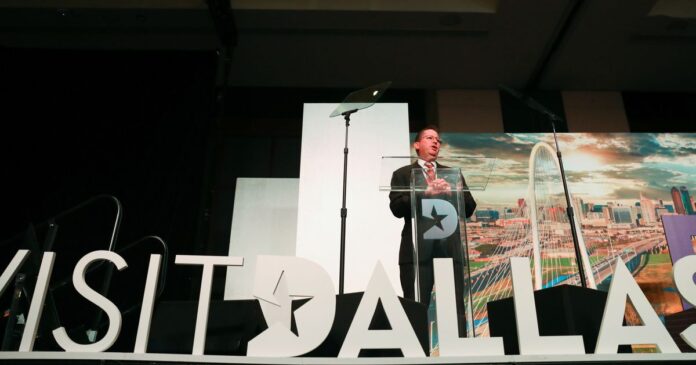The South Oak Cliff High School marching band’s bass drums reverberated through Kay Bailey Hutchison Convention Center on Thursday morning, literally knocking dust from the overhead lights.
It was the first time VisitDallas, the city’s nonprofit tourism bureau, has held its annual meeting in person since 2019. Public health regulations and an abundance of caution have kept previous meetings virtual and optimism about the future tempered.
But no longer.
At the convention center, hundreds of business leaders listened to hopeful speakers preach about resilience. Summer 2022 could mark the beginning of a more prosperous period for hotels, restaurants and other businesses that cater to tourists.
VisitDallas CEO Craig Davis said the industry is “embarking on a rapid comeback from the pandemic.” U.S. Travel Association president and CEO Roger Dow called Texas “the comeback state” and Dallas “the comeback city.”
Businesses in the tourism and hospitality industry have been the hardest hit of the pandemic era. In Dallas, group bookings at hotels plummeted and convention center clients canceled events en masse, resulting in a more than $1 billion loss, according to VisitDallas.
The economic toll for the industry overall was more pronounced than 9/11 and the 2008 financial crisis combined, the tourism bureau said.
Restoring tourist spending in Dallas is essential to the city’s growth plans in the near future. It recently approved a $2 billion plan to expand the convention center that will be paid for through hotel taxes, and Dallas aspires to lure the FIFA World Cup to town in 2026.
Former ambassador and senator Kay Bailey Hutchison speaks at the 2022 Visit Dallas annual meeting on May 19 at the Kay Bailey Hutchison Convention Center in downtown Dallas.(Liesbeth Powers / Special Contributor)
Speaking at the meeting, the convention center’s namesake, Kay Bailey Hutchison, praised city officials for passing the expansion plan.
“The historic investment in this convention center is an investment in Dallas,” she said.
In the last two years, Dallas area hotel, restaurant and event companies have weathered not just unfavorable public health regulations but also a statewide power grid failure, inflation and a labor market that’s been turned on its head for the foreseeable future.
Leisure travel is returning, and the U.S. is bracing for a very busy summer travel season. But in the eyes of the industry’s biggest advocate, hurdles remain.
During the event’s keynote speech, Dow said a patchwork of public health standards, pre-flight COVID-19 testing rules and wait times for travel visas are still hampering the travel and tourism industry. Slow-to-recover conference and business travel are also pain points.
“If you look at it in Texas and Florida, we’re so different than the rest of the United States for travel and tourism and how they handled the pandemic,” Dow said. “You compare that to California or New York, it’s a night-and-day difference.”
/cloudfront-us-east-1.images.arcpublishing.com/dmn/QWE2TUBNBRDFZJAB7L3S3CNWEI.jpg) Members of the Dallas Black Dance Theatre perform a dance to “A Sunday Kind of Love” at the 2022 VisitDallas meeting.(Liesbeth Powers / Special Contributor)
Members of the Dallas Black Dance Theatre perform a dance to “A Sunday Kind of Love” at the 2022 VisitDallas meeting.(Liesbeth Powers / Special Contributor)
Dow drew laughter when he criticized the U.S. Centers for Disease Control and Prevention, describing the agency as “a little bit schizophrenic.”
The U.S. still requires a negative COVID test for international travelers coming here.
“How can you sit there and go to a Mavericks game or go to the Byron Nelson and see 20,000 people screaming and yelling and obviously not wearing masks and say ‘Oh, but when you get on a plane it’s dangerous’? No, it’s not,” Dow said. “So hopefully that doesn’t come back. The CDC is a little bit schizophrenic. You never know what’s gonna happen with them.”
The Dallas Mavericks dropped mask requirements at their games at American Airlines Center in March as the omicron wave of COVID-19 subsided.
Dow also encouraged the travel business leaders at the meeting to find new ways to appeal to a younger generation of workers.
“Our industry has almost 75% of all the jobs that can’t be filled,” Dow said, adding that a lot of those workers have left the workforce entirely.
“We’ve got to think more creatively. We’ve got to think differently. We’ve got to think about part-time [work] and the gig economy,” he urged. “We’ve got to think about how we can bring people back to work.”













